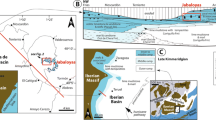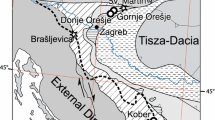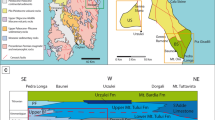Summary
In the area of Haidach (Northern Calcareous Alps, Austria), coral-rudist mounds, rudist biostromes, and bioclastic limestones and marls constitute an Upper Cretaceous shelf succession approximately 100 meters thick. The succession is part of the mixed siliciclasticcarbonate Gosau Group that was deposited at the northern margin of the Austroalpine microplate.
In its lower part, the carbonate succession at Haidach comprises two stratal packages that each consists, from bottom to top, of a coral-rudist mound capped by a rudist biostrome which, in turn, is overlain by bioclastic limestones and, locally, marls. The coral-rudist mounds consist mainly of floatstones. The coral assemblage is dominated by Fungiina, Astreoina, Heterocoeniina andAgathelia asperella (stylinina). From the rudists, elevators (Vaccinites spp., radiolitids) and recumbents (Plagioptychus) are present. Calcareous sponges, sclerosponges, and octocorals are subordinate. The elevator rudists commonly are small; they settled on branched corals, coral heads, on rudists, and on biolastic debris. The rudists, in turn, provided settlement sites for corals. Predominantly plocoid and thamnasteroid coral growth forms indicate soft substrata and high sedimentation rates. The mounds were episodically smothered by carbonate mud. Many corals and rudists are coated by thick and diverse encrustations that indicate high nutrient level and/or turbid waters.
The coral-rudist mounds are capped byVaccinites biostromes up to 5 m thick. The establishment of these biostromes may result from unfavourable environmental conditions for corals, coupled with the potential of the elevator rudists for effective substrate colonization. TheVaccinites biostromes are locally topped by a thin radiolitid biostrome. The biostromes, in turn, are overlain by bioclastic limestones; these are arranged in stratal packages that were deposited from carbonate sand bodies. Approximately midsection, an interval of marls with abundantPhelopteria is present. These marls were deposited in a quiet lagoonal area where meadows of sea grass or algae, coupled with an elevated nutrient level, triggered the mass occurrence ofPhelopteria.
The upper part of the Haidach section consists of stratal packages that each is composed of a rudist biostrome overlain by bioclastic wackestones to packstones with diverse smaller benthic foraminifera and calcareous green algae. The biostromes are either built by radiolitids,Vaccinites, andPleurocora, or consist exclusively of radiolitids (mainlyRadiolites). Both the biostromes and the bioclastic limestones were deposited in a low-energy lagoonal environment that was punctuated by high-energy events.In situ-rudist fabrics typically have a matrix of mudstone to rudistclastic wackestone; other biogens (incl. smaller benthic foraminifera) are absent or very rare. The matrix of rudist fabrics that indicate episodic destruction by high-energy events contain a fossil assemblage similar to the vertically associated bioclastic limestones. Substrata colonized by rudists thus were unfavourable at least for smaller benthic foraminifera.
The described succession was deposited on a gently inclined shelf segment, where coral-rudist mounds and hippuritid biostromes were separated by a belt of bioclastic sand bodies from a lagoon with radiolitid biostromes. The mounds document that corals and Late Cretaceous elevator rudists may co-occur in close association. On the scale of the entire succession, however, mainly as a result of the wide ecologic range of the rudists relative to corals, the coral-dominated mounds and the rudist biostromes are vertically separated.
Similar content being viewed by others
References
Aigner, T. (1985): Storm Depositional Systems. Dynamic Stratigraphy in Modern and Ancient Shallow-Marine Sequences. —Lecture Notes in Earth Sciences,3, 1–174, Berlin (Springer)
Barnes, R. S. K. &Hughes, R. N. (1988): An Introduction to Marine Ecology.—351 p. Oxford (Blackwell)
Baron-Szabo, R. C. (1994): Palökologie von nordspanischen Korallen des Urgon (Playa de Laga, Prov. Guernica, N-Spanien). —Berliner geowiss. Abh. (E),13, 441–451, Berlin
Baron-Szabo, R. C. (1996): Zur Korallenfazies der ostalpinen Kreide (Helvetikum: Allgäuer Schrattenkalk; Nördliche Kalkalpen: Brandenberger Gosau). Taxonomie, Palökologie. —Unpubl. Ph. D. thesis, University of Berlin, 113 p.
Bosence, D. W. J. &Bridges, P. H. (1995): A review of the origin and evolution of carbonate mud-mounds.—In:Monty, C. L. V., Bosence, D. W. J., Bridges, P. H. &Pratt, B. R. (eds.): Carbonate Mud-Mounds.—Int. Ass. Sediment., Spec. Publ.,23, 3–9, Oxford (Blackwell)
Boucot, A.J. (1981): Principles of Benthic Marine Paleoecology. —463 p., New York (Academic)
Camoin, G., Bernet-Rollande, M.-C. &Philip, J. (1988): Rudistcoral frameworks associated with submarine volcanism in the Maastrichtian of the Pachino area (Sicily).—Sedimentology,35, 123–138, Oxford (Blackwell)
Carbone, F. &Sirna, G. (1981): Upper cretaceous reef models from Rocca di Cave and adjacent areas in Latium, Central Italy.—Soc. econ. Pal. Min., Spec. Publ.,30, 427–445, Tulsa
Channell, J. E. T., Brandner, R., Spieler, A. &Smathers, N. P. (1990): Mesozoic paleogeography of the Northern Calcareous Alps-Evidence from paleomagnetism and facies analysis. —Geology,18, 828–831, Boulder
Chase, T. L. (1983): The effects of sediment and hydrology on coral growth forms: recent and Devonian.—Abst. Fourth. Int. Symp. Fossil Cnidaria,2; Washington.
Freytet, P. (1973): Edifices récifaux développés dans un environnement détritique: exemple des biostromes à hippurites (rudistes) du Sénonien inférieur du Sillon Languedocien (région de Narbonne, sud de la France). Paleogeogr., Paleoclimatol., Paleoecol.,13, 65–76, Amsterdam (Elsevier)
Fütterer, D. K. (1974). Significance of the boring spongeCliona for the origin of fine-grained material of carbonate sediments. —Jour. Sed. Pet.,44/1, 79–84, Tulsa
Geister, J. (1983): Holozäne westindische Korallenriffe: Geomorphologie, Ökologie und Fazies.—Facies,9, 173–284, Erlangen
Gili, E., Skelton, P. W., Vicens, E. &Obrador, A. (1995): Corals to rudists—an environmentally induced assemblage succession.—Palaeogeogr., Palaeoclimatol., Palaeoecol.,119, 127–136, Amsterdam (Elsevier)
Ginsburg, R.N. (ed.) (1972): South Florida Carbonate Sediments (Reprint of the 1964 Field Trip Guide).—Sedimenta II, The University of Miami, Miami, 70pp., Florida.
Gradstein, F. M., Agterberg, F. P., Ogg, J. G., Hardenbol, J., Van Veen, P., Thierry, J. &Huang, Z. (1994): A Mesozoic time scale.—J. Geophys. Res.,99/B12, 24,051–24,074, Washington (American Geophys. Union)
Granier, B. (1986): LesPienina oblonga Borza etMisik, 1976 sont-elles des sclérites d’alcyonaire?—Rev. de Micropaléont.,29/2, 103–108, Paris
Gili, E., Skelton, P. W., Vicens E. &Obrador, A. (1995): Corals to rudists—an environmentally induced assemblage succession.—Palaeogeogr., Palaeoclimatol., Palaeoecol.,119, 127–136, Amsterdam (Elsevier)
Hallock, P. (1988): The role of nutrient availability in bioerosion: consequences to carbonate buildups.—Paleogeogr., Paleoclimatol., Paleoecol.,63, 275–291, Amsterdam (Elsevier)
Heckel, P. H. (1974): Carbonate buildups in the geologic record: A review.—In:Laporte, L. F., (ed.): Reefs in Time and Space. Selected Examples from the Recent and Ancient.—Soc. econ. Pal. Min., Spec. Publ.,18, 90–154, Tulsa
Herm, D. (1977): Zyklische Regressions-Sedimentation und Fossil-Vergesellschaftungen in der Gosau (Santonium) von Brandenberg/Tirol. —Mitt. Bayer. Staatsslg. Paläont. hist. Geol.,17, 257–277, München
Herm, D., Kauffman, E. &Wiedmann, J. (1979): The age and depositional environment of the “Gosau”-Group (Coniacian-Santonian), Brandenberg/Tirol, Austria.—Mitt. Bayer. Staatssammlg. Paläont. hist. Geol.,19, 27–92, München
Höfling, R. (1985): Faziesverteilung und Fossilvergesell-schaftungen im karbonatischen Flachwasser-Milieu der alpinen Oberkreide (Gosau-Formation).—Münchner geowiss. Abh., Reihe A,3, 240pp., München
Höfling, R. (1994): Cretaceous bioconstruction-types: Examples from Alpine-Mediterranean sequences.—15th Reg. Meet. Int. Assoc. Sedimentol., Abstract Volume, p. 215.
Hubbard, J. A. B. &Pocock, Y. P. (1972): Sediment rejection by recent scleractinian corals: a key to paleo-environmental reconstruction.—Geol. Rundschau,6/2, 598–626, Berlin
James, N. P. (1983): Reefs.—In:Scholle, P. A., Bebout, D. G. & Moore, C. H. (eds.): Carbonate Depositional Environments. —Amer. Assoc. Petrol. Geol. Memoir,33, 345–362, Tulsa
James, N. P. &Bourque, P.-A. (1992): Reefs and mounds.—In:Walker, R. G. &James, N. P. (eds.): Facies Models. Response to Sea Level Change, 323–345, Ontario (Geol. Assoc. Canada)
Kauffman, E. G. (1973): Cretaceous Bivalvia.—In:Hallam, A. (ed.): Atlas of Paleobiogeography, 353–383, Amsterdam (Elsevier)
Kauffman, E. G. &Sohl, N. F. (1974): Structure and Evolution of Antillean Cretaceous Rudist Frameworks.—Verhandl. Naturforsch. Ges. Basel,84, 1, 399–467, Basel
Kauffman, E. G. &Johnson, C. C. (1988): The Morphological and Ecological Evolution of Middle and Upper Cretaceous Reef-Building Rudistids.—Palaois,3, 194–216, Tulsa
Kidwell, S. M. &Aigner, T. (1984): Sedimentary dynamics of complex shell beds: Implications for ecologic and evolutionary patterns.—In:Bayer, U. &Seilacher, A. (eds.): Sedimentary and evolutionary cycles, 382–395, Berlin (Springer)
Kobluk, D. R. &Risk, M. J. (1977): Micritization and carbonategrain binding by endolithic algae. Amer. Assoc. Petrol. Geol. Bull.,61, 7, 1069–1082., Tulsa
Littler, M. M. & Littler, D. S. (1984): A relative-dominance model for biotic reefs. In: Advances in Reef Science. Joint meeting of the Atlantic Reef Committee and The International Society for Reef Studies, Miami, Florida, October 26–28, 1984, Abstracts of Papers, p. 73–74, Miami, Florida
Mauritsch, H. J. &Becke, M. (1987): Paleomagnetic investigations in the Eastern Alps and the southern border zone.—In:Flügel, H. W. &Faupl, P. (eds.): Geodynamics of the Eastern Alps, 282–308, Vienna (Deuticke)
Parkinson, R. W. &Meeder, J. F. (1991): Mud-bank destruction and the formation of a transgressive sand sheet, southwest Florida inner shelf.—Geol. Soc. Amer. Bull.,103, 1543–1551, Boulder
Philip, J. (1972): Paleoécologie des formations à rudistes du Crétacé Supérieur: l’exemple du sud-est de la France.— Paleogeogr., Paleoclimat., Paleoecol.,12, 205–222, Amsterdam (Elsevier)
Platt, J. P. (1986): Dynamics of orogenic wedges and the uplift of high-pressure metamorphic rocks.—Geol. Soc. Amer. Bull.,97, 1037–1053, Boulder
Ratschbacher, L., Frisch, W., Neubauer, F., Scimid, S. M. &Neugebauer, J. (1989): Extension in compressional orogenic belts: The Eastern Alps.—Geology,17, 404–407, Boulder
Ross, D. J. (1992): Sedimentology and depositional profile of a mid-Cretaceous shelf edge rudist reef complex, Nahal Ha’mearot, northwestern Israel.—Sedim. Geol.,79, 161–172, Amsterdam
Ross, D. J. &Skelton, P. W. (1993): Rudist formations of the Cretaceous: a paleoecological, sedimentological and stratigraphical review.—In:Wright, P. (ed.): Sedimentology Review,1, 73–91, Oxford (Blackwell)
Philip, J., Masse, J.-P. &Camoin, G. (1995): Tethyan Carbonate Platforms.—In:Nairn, A. E. M., Ricou, L.-E., Vrielynck, B. &Dercourt, J. (eds.): The ocean basins and margins. Volume 8: The Tethys Ocean, 239–265, New York (Plenum Press)
Sanders, D. (1994): Carbonate Platform Growth and Erosion: The Cretaceous-Tertiary of Montagna della Maiella, Central Italy.—Ph. D. thesis No. 10800, ETH Zürich, 122 p.
Sanders, D. (1996 a): Rudist biostromes on the margin of an isolated carbonate platform: The Upper Cretaceous of Montagna della Maiella, Italy.—Eclogae geol. Helv.,89/2, 845–871, Basel (Birkhäuser)
Sanders, D. (1996 b): Coral-rudist mounds and sponge-rudist mounds in the Upper Cretaceous of Brandenberg (Austria).—In: Sediment ’96. 11. Sedimentologentreffen, Geo-Zentrum, Universität Wien, Abstracts, p. 151.
Sanders, D. (1996 c): Boring of elevator rudists: examples fromVaccinites “sulcatus” (Hippuritidae) and Radiolitidae.—In: Fifth Internat. Cretaceous Symposium and Second Workshop on Inoceramids. Freiberg University of Mining and Technology, September 16–24, 1996, Abstracts, p. 152.
Sanders, D. (1996 d): A classification of elevator rudist biostromes. In: Fifth Internat. Cretaceous Symposium and Second Workshop on Inoceramids. Freiberg University of Mining and Technology, September 16–24, 1996, Abstracts, p. 153, Freiberg.
Schumann, D. (1995): Upper Cretaceous rudist and stromatoporoid associations of Central Oman (Arabian Peninsula).—Facies,32, 189–202, Erlangen
Scoffin, T. P. (1993): Microfabrics of Carbonate Muds in Reefs. —In:Rezak, R. &Lavoie, D. L. (eds.): Carbonate Microfabrics. —65–74, Berlin (Springer)
Scott, R. W. (1995): Global environmental controls on Cretaceous reefal ecosystems.—Paleogeogr., Paleoclimatol., Paleoecol.,119, 187–199, Amsterdam (Elsevier)
Seilacher, A. (1984): The Jeram model: Event condensation in a modern intertidal environment.—In:Bayer, U. &Seilacher, A. (eds.): Sedimentary and evolutionary cycles.—336–341, Berlin (Springer)
Skelton, P. W. (1976): Functional morphology of the Hippuritidae. —Lethaia,9, 83–100, Oslo (Scandinavian University Press)
Skelton, P. W. (1979): Gregariousness and Proto-Cooperation in Rudists (Bivalvia).—In:Larwood, G. &Rosen, B. R. (eds.): Biology and Systematics of Colonial Organisms.— Systematics Association, Special Volume,11, 257–279, London (Academic)
Skelton, P. &Gili, E. (1991): Palaeoecological classification of rudist morphotypes.—In:Sladic-Trifunovic, M. (ed.): First International Conference on Rudists, October 1988, Proceedings, 71–86, Belgrade (Serbian geol. Soc.)
Skelton, P. W., Gili, E., Vicens, E. &Obrador, A. (1995): The growth fabric of gregarious rudist elevators (hippuritids) in a Santonian carbonate platform in the southern Central Pyrenees. —Paleeogeogr., Palaeoclimatol., Palaeoecol.,119, 107–126, Amsterdam (Elsevier)
Summesberger, H. &Kennedy, W. J. (1996): Turonian ammonites from the Gosau Group (Upper Cretaceous; Northern Calcareous Alps, Austria); with a revision ofBarroisiceras haberfellneri (Hauer, 1866).—Beitr. Paläont.,21, 105–177, Wien.
Wagreich, M. &Faupl, P. (1994): Paleogeography and geodynamic evolution of the Gosau Group of the Northern Calcareous Alps (Late Cretaceous, Eastern Alps, Austria).—Paleogeogr., Paleoclimatol., Paleoecol.,110, 235–254, Amsterdam (Elsevier)
Wanless, H. R., Cottrell, D. J., Tagett, M. G., Tedesco, L. P. &Warzeski Jr.,E. R. (1995): Origin and growth of carbonate banks in south Florida—In:Monty, C. L. V., Bosence, D. W. J., Bridges, P. H. &Pratt, B. R. (eds.): Carbonate Mud-Mounds. —Int. Ass. Sediment., Spec. Publ.23, 439–473, Oxford (Blackwell)
Warme, J. E. (1977): Carbonate Borers—Their Role in Reef Ecology and Preservation.—In:Frost, S. H., Weiss, M. P. & Saunders, J. B. (eds.): Reefs and Related Carbonates-Ecology and Sedimentology.—Amer. Assoc. Petrol. Geol., Studies in Geology,4, 261–279 Tulsa
Wilson, J. L. (1975): Carbonate Facies in Geologic History.— 471 p., New York (Springer)
Wood, R. (1993): Nutrients, Predation and the History of Reef-Building. —Palaios,8, 526–543, Tulsa
Author information
Authors and Affiliations
Rights and permissions
About this article
Cite this article
Sanders, D., Baron-Szabo, R.C. Coral-rudist bioconstructions in the Upper Cretaceous Haidach section (Gosau Group; Northern Calcareous Alps, Austria). Facies 36, 69–89 (1997). https://doi.org/10.1007/BF02536878
Received:
Revised:
Issue Date:
DOI: https://doi.org/10.1007/BF02536878




